
How to Attract B2B Buyers with Killer Content
Content marketing is still booming.
According to research from Content Marketing Institute in July 2020, 70% of B2Bs listed content marketing as their number one investment priority for 2021.
37% of B2Bs also admitted that they hadn’t spent any money on paid ads within the past 12 months. Hear that? Nothing!
Another 24% said they even shifted money away from paid ads in favor of content marketing over the same period.
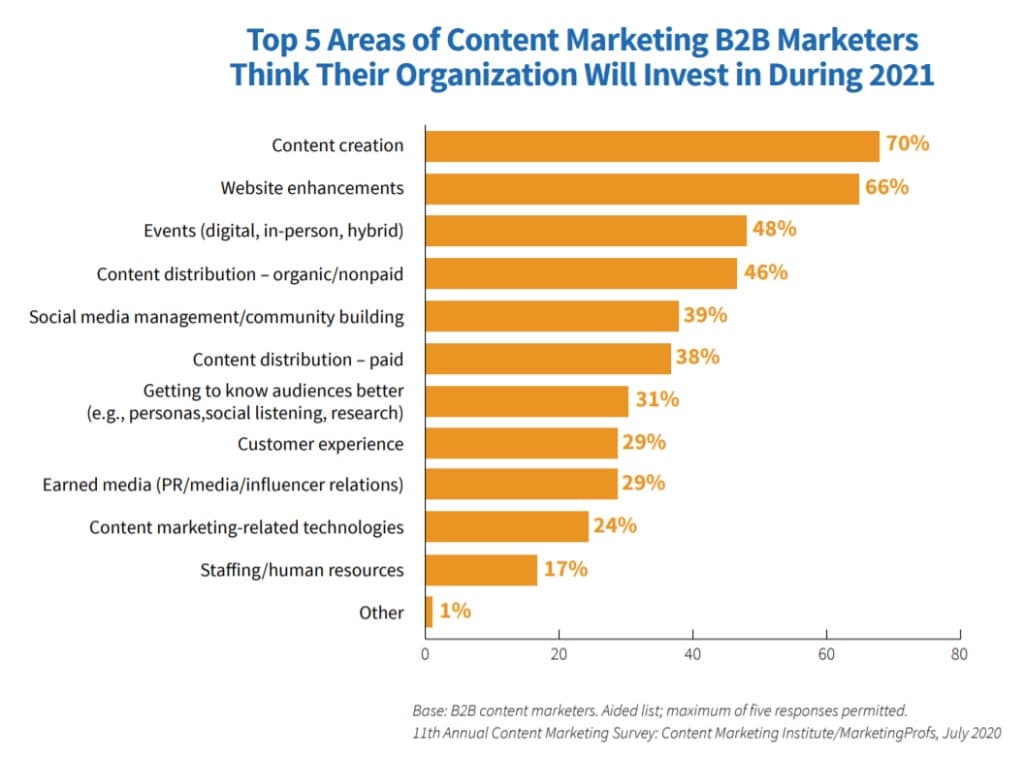
And yet most companies are not creating effective content. Want proof?
74% of global B2Bs say they have no concrete formula for attributing content like thought leadership to direct sales impact.
It gets worse.
89% of decision makers say they use thought leadership content to inform their opinion of a brand but only 15% would call the content they consume “excellent.”
Your content and sales competition grows more intense every day, with avalanches of new content sliding into the market. And let’s face it, creating compelling content is hard.
In short, many seem to believe that content creation, in and of itself, will win the day.
It won’t.
You really need the right content. The best content. The most relevant and useful content.
Mastering the five critical steps below will help you create content for B2Bs that resonates with them and appeals to their direct needs.
Quick Takeaways:
- Find your niche after carefully analyzing the market to create the right content.
- A deeper understanding of your target audience is a must to create relevant content.
- Identify and articulate your true value right from the beginning.
- Define your objectives as well as you can before creating content.
- Be respectful and empathetic with your prospective customers.
Step 1: Analyze the Market and Find Your Niche to Create Content for B2B
Media companies, marketing agencies, and our own egos often lure us into the crazy idea of expanding our target market.
We do so in the name of economies of scale or because we fear missing out on revenue opportunities.
Don’t do it. Focus, focus, focus.
Start with a rigorous exercise of looking at your current customers for the solution you are trying to sell.
Begin with qualitative intelligence-gathering. Talk to the best salespeople, the product team, the post-sales team, and the sales engineers:
- Who are your most profitable accounts and why?
- Which accounts have the greatest longevity and why?
- What do these accounts have in common?
- What accounts are unprofitable and why?
- How can we avoid them?
Then do quantitative analysis, ideally matching your customers to third-party databases to add dimension to your profiles.
Share your findings with the most relevant stakeholders to build a consensus on the ideal customer profile.
Define account characteristics next.
Break your market into two or three segments, based upon their potential value. If you can only afford to speak to one of the segments through content, choose the most valuable one.
(That’s often the market leader. If you can win them over, they’ll influence the rest of the market.)
Please understand.
Your content niche definition today will change tomorrow.
Make this research exploration an annual exercise for every solution you sell. For new solution categories, you may need a running dialogue until you find the ideal customer profile, experimenting as you create content for B2Bs.
Of course, find different ways to test and optimize your content messaging hypothesis.
For companies with multiple products and services, you’ll generally want to find one solution easiest for opening the door to your other products and services.
Think Long-Term Demand Generation: Create Content for B2B Markets You Can Eventually Corner
Look at Microsoft. Here’s a snapshot of the company’s milestones up to their Skype acquisition in 2011:

That timeline actually leaves a lot of critical stuff out…
Microsoft started out making tools for programmers.
Those sales attracted the most technically savvy people, a group with enormous influence over the next wave of early adopters.
Next, Microsoft created an operating system. (Well, Microsoft bought one and licensed it to IBM, to be perfectly accurate).
That operating system opened a huge door. It created a demand for desktop productivity products like Word and Excel. Microsoft’s relationship with developers encouraged them to build other desktop software and utilities.
Microsoft gradually expanded from the desktop to the network and the applications on the system.
Initially, the enterprise applications were back office-focused but gradually turned customer-facing, like Dynamics CRM, Bing, and now LinkedIn.
This sequencing idea is the essence of product strategy and a key to demand generation success.
It should also be a central concept behind your long-term strategy as you create content for B2Bs. Enterprises plan for years or decades. If you want to play with them, you must too.
Step 2: Understand Your Audience to Create Relevant Content for B2B
Once you are clear on the target account segments you want to attract and the precise value you offer them, it’s time to understand the decision dynamics for marketing your solution in those accounts.
While you will want to look at the entire path to purchase, let’s focus our attention on the top of the funnel…
Who Would Be Your Biggest Cheerleader?
End-users might rave about your product but that doesn’t mean they can vote in buying decisions.
Search for one person inside an organization who can influence others. Who cares about this person’s opinion? Where does that person fit into the buying process?
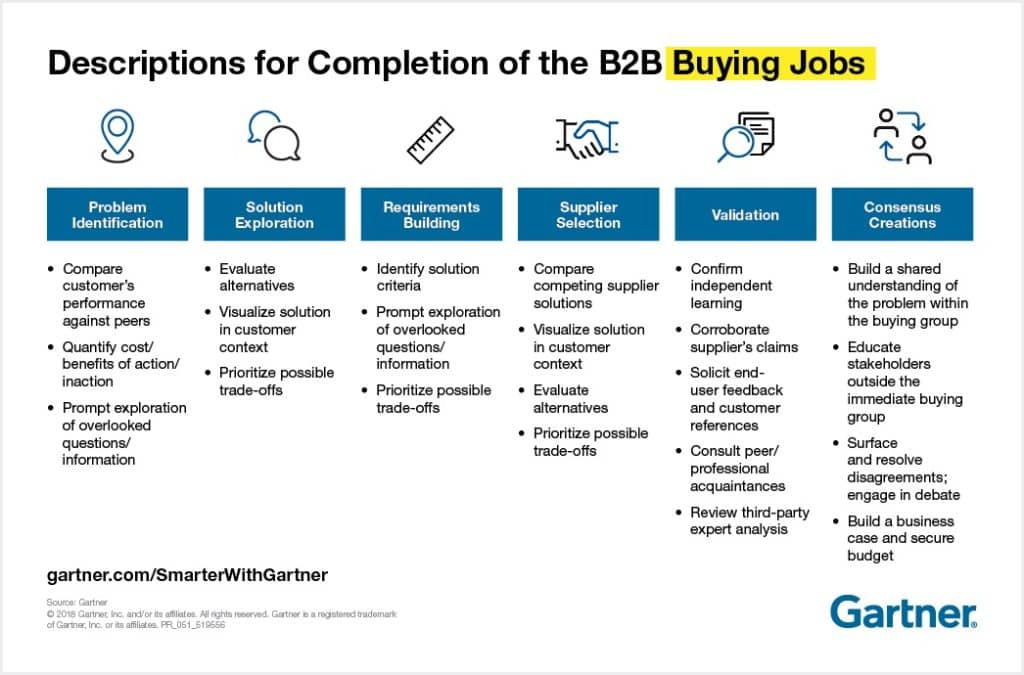
Many try. Few succeed. Think about the functional role, the attitudes, the personality type, the credentials, the likely beliefs, and so on.
This persona is who you are speaking to as you create content for B2Bs.
Keep them in your head as you write, like you’re having a conversation.
- What language/tone do they use?
- What stats do they need to convince stakeholders to see what they see in you?
- What benefits can they leverage in their discussions with stakeholders?
- How can your product make them look better to stakeholders or improve their standing?
Don’t ever withhold information from them, hoping they’ll reach out for details to back up their claims about you. Empower them from the start with interesting content.
What Trigger Events Motivate Your Audience’s Decisions?
Trigger events are the situations that would make your target audience seriously consider your solution.
The content you create for B2Bs should straddle problem identification and solutions exploration:
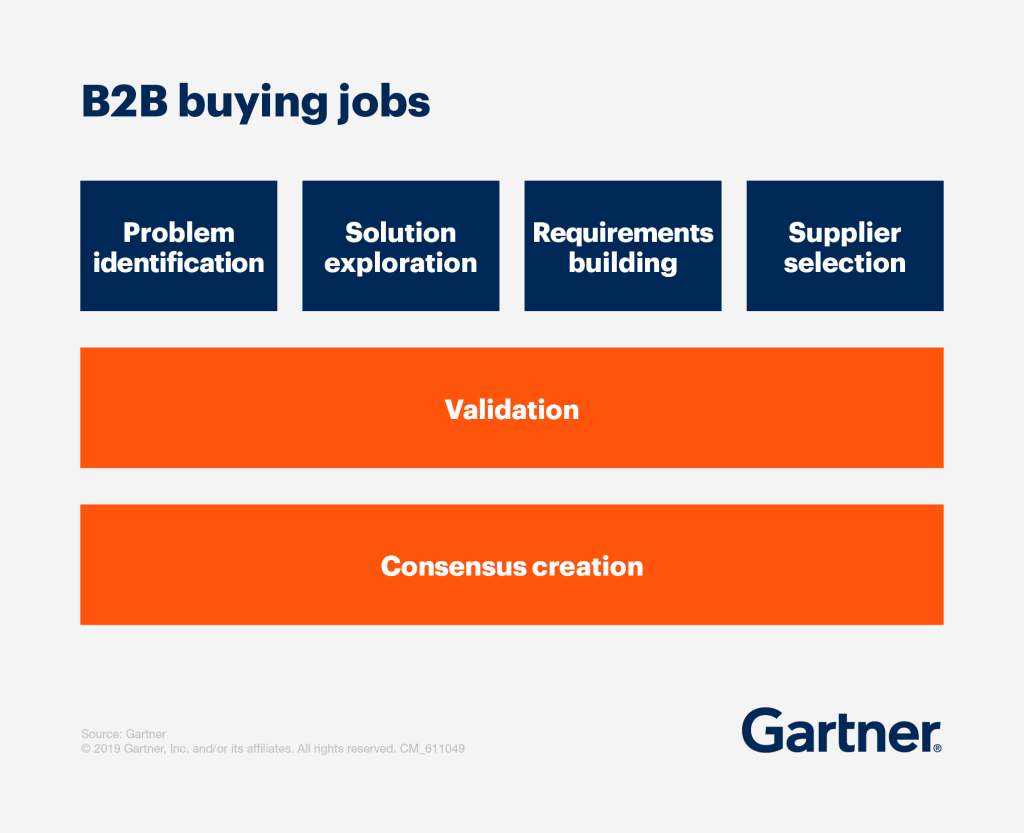
Essentially, they bring detailed context and relevant examples to the standard “what’s in it for me?” question.
Trigger events can be positive or negative. (Although, people are usually far more motivated by pain-avoidance than by gain-attainment.)
These events can happen within a company or externally. They can happen on a day or over an extended period.
Ideally, these are problems your company can help address if not completely eliminate.
You’ll want to understand what those trigger events are, like:
- Layoffs
- Leadership changes
- New regulations
- Rapid growth
- Competitive encroachment
- VC funding rounds
- Employee turnover
- Customer churn
- Economic tectonic shifts
- Industry disruption
Leverage one or more trigger events to connect what your cheerleader cares about to the possibility your solution might make a material difference.
Make sure to research the prevalence of these trigger events in your target market to gauge the possible volume of demand that might exist. Use stats and examples you’ve learned as you create content for B2Bs to back up your points.
Visualizing these trigger events through content builds a clear bridge between what your prospect understands and what they haven’t considered.
Plus, it shows you’re tapped into their problems and equipped to provide long-term proactive solutions.
What High-Risk Looming Dangers Has Your Audience Ignored?
For people to change, the status quo must become unsafe or be at risk of imminent danger.
Businesses are no different. Plus, they don’t like to fix things that aren’t broken because it always involves risk.
Of all the problems on their plate and other well-known issues, why should they care about the problem you solve that isn’t even on their radar?
You must help your audience see what they do not see as you create content for B2Bs.
Jill Konrath in her excellent book, SNAP Selling, talks about “crazy busy” buyers.
These people get so enthralled in the day-to-day whirlwind of their jobs, they get tunnel vision and lose perspective.
You want to help them see their situation with new eyes. This is the heart of the story you must tell as you create content for B2Bs.
To tell this story well, you really must understand the implications of these unmet needs:
- Who is impacted by the status quo?
- What will doing nothing cost in worst/best case scenarios?
- What will addressing the issue cost?
- Does addressing the issue now, through you, come with other benefits?
If you can quantify the benefit financially, you will empower your cheerleader with the universal language of money, a language that everyone understands.
Consider now which of these points you’ll insert yourself into and with what types of content:
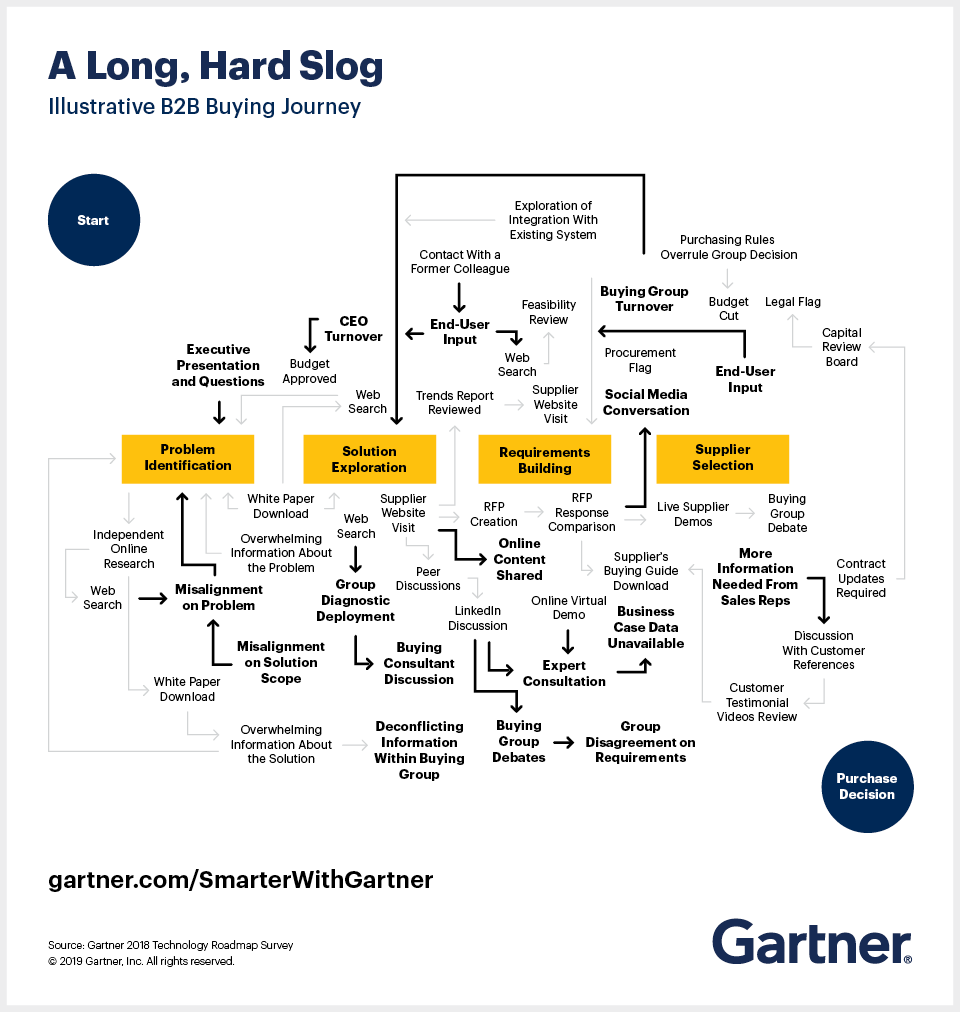
What Do You Need Your Cheerleader to Believe?
You are not trying to get a cheerleader to buy your solution at this point.
You need to trigger your cheerleader into sharing your story enthusiastically with others.
To do so, they need to believe a few things:
- Your solution offers so many groundbreaking benefits it must be considered above everything else.
- The problem your solution solves is such a threat that ignoring it is dangerous.
Enforcing one or both of these beliefs is a gradual process. Move too fast and you risk appearing exploitative, aggressive, or sensational.
Steppingstone beliefs are important.
For example, I was just looking at a cool software program that understands written email responses, including their tone and sentiment:
- One steppingstone belief is that the AI engine can actually understand the nuances of the written language.
- Another is that my prospects won’t know they’re communicating with a computer.
- A third might be that the program won’t inadvertently annoy my prospects.
Finally, I get to the question: Do I need this program right now to fix my status quo?
Consider this thought process as you create content for B2Bs.
What’s Your Evidence?
Remember, your audience for this content isn’t the person you have to convince into buying.
Your cheerleader isn’t the decisionmaker. They’re already rooting for you.
You are only trying to earn enough commitment to move the prospect from their status quo to interest in having a conversation with your company.
Still, you need sufficient evidence to make the promise you are making credible enough to warrant the time for a deeper look at your solution.
You need to marshal sufficient evidence to address the key beliefs your cheerleader must have, both about your solution to the problem and the viability of your company.
Remember your job is to help them. That delivers the best results:
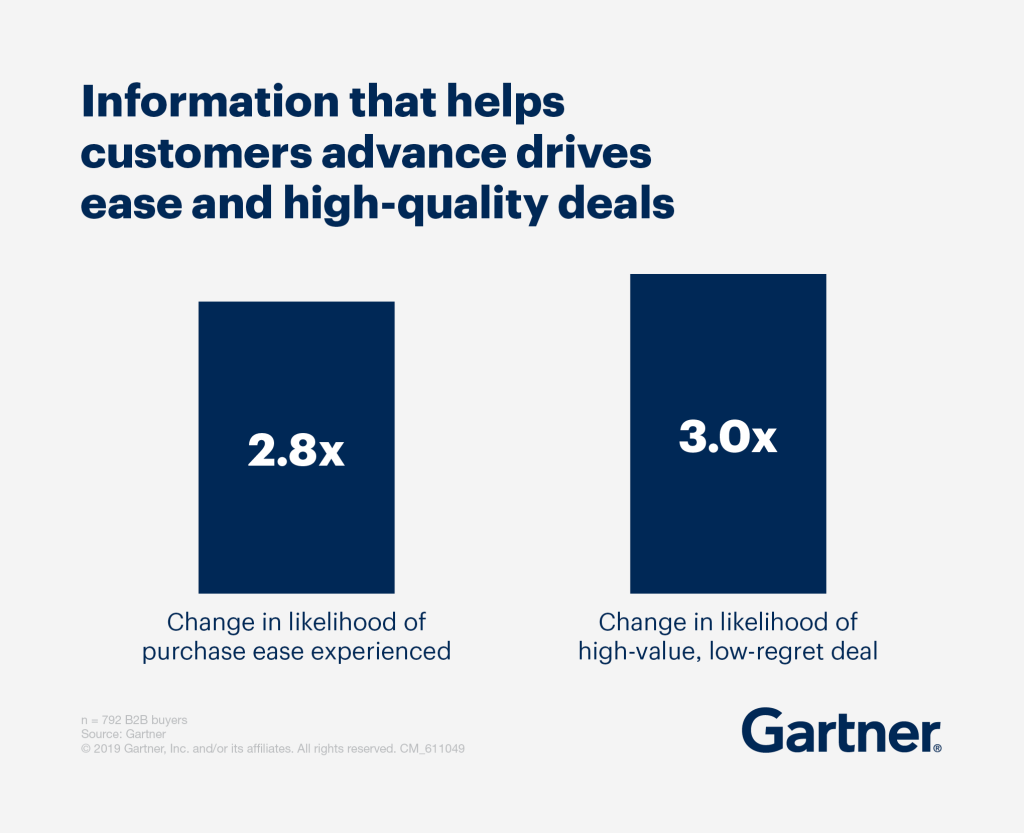
Ideally, you get most of this information through direct interviews and/or focus groups, augmented with simple surveys.
Usually, five to ten interviews will give you what you need.
If the information you hear gets redundant, you’ll know you have talked to enough people.
One tip: Talk to these individuals during the purchase process or shortly after that while the experience is top of mind.
Commissioning original research also arms you with statistics on your target prospect’s peers, their concerns, their problems, and their behavior.
Step 3: Clearly Articulate Your True Value as You Create Content for B2B
Duh! Right?
Yet, how often do you see words like “leading,” “exceptional,” “largest,” “greatest,” and other unbelievable, vague, vacuous claims?
One reason social media is so popular is that people want another source of information they can trust: information from their friends. Really, anyone but the vendor and its media conspirators.
Unsurprisingly, 45% of buyers say they wish vendors would improve transparency:
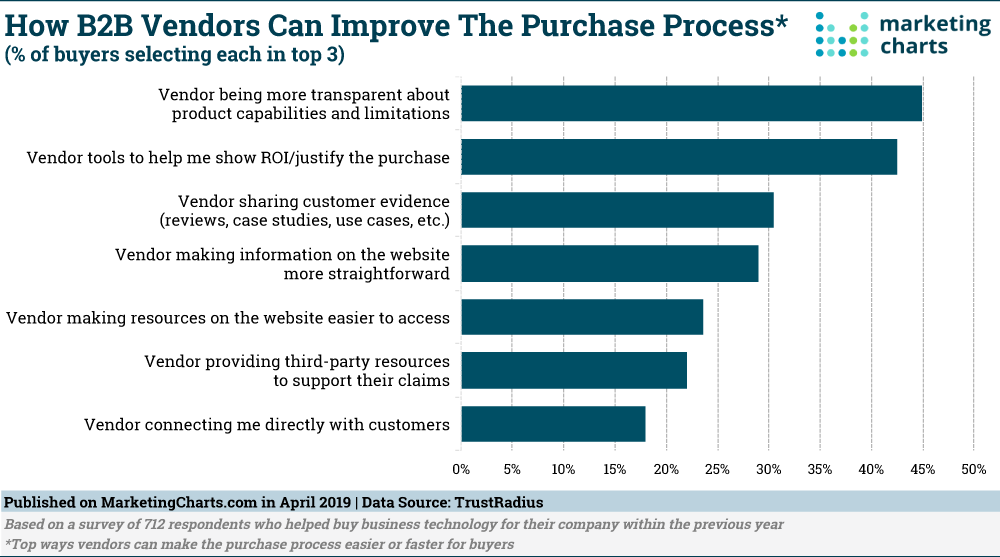
In fact, they rank your website and any material you provide as the least trustworthy source on your company and product.
Part of the problem is you have too many remarkable things to say about your solution and your company.
But verbosity is confusing and boring. If you really research your market, you’ll have far more to share than you will need at the top of the funnel.
To find your value, look at your solution through an honest, competitive lens and through the eyes of your customer.
You’re looking for something your ideal customer wants and your competition doesn’t have. If your customers don’t want it, it doesn’t matter. If your customers want it and your competitors can also provide it, you’ll be in a low-margin commodity business.
Instead, look for your only factors, the ones your customers care deeply about and that only your company can make.
Half the battle is getting your key stakeholders in a room to really grapple with this problem and come to a consensus.
Look for three specific areas where you stand out and then build your messaging and story around these three value positions as you create content for B2Bs.
Step 4: Define Your Objective Before You Create Content for B2B
Your objective isn’t to build your brand either
That can certainly happen as a by-product of your efforts, but it’s not the goal.
The role of content at the top of the funnel is not to generate clicks, traffic, inbound calls, or even leads, either. It’s also not to sell your product or service. That may be the endgame, but it’s not the objective at the top of the funnel.
I like to think of the objective as going to a party.
Yes, you might secretly hope to meet the man or woman of your dreams, but you don’t go around asking attractive people to marry you.
Rather, you’re just trying to spark a conversation, typically by being observant and interested in the other person.
That’s the goal with demand generation.
Show enough insight and interest to spark a conversation and pique interest. Within the demand generation framework, each element must support that objective. If not, trim the fat, using your objective as a knife.
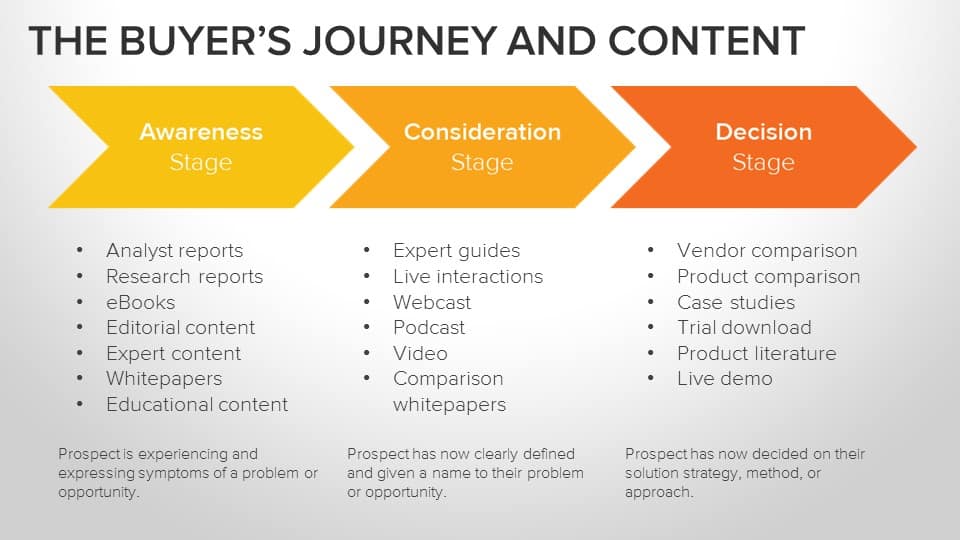
Step 5: Love Your Prospective Customers
It might seem obvious, but there is a reason sales and marketing often have bad reputations in the public square.
Loving your customers starts with being respectful and empathetic toward them. And that means being authentic and honest, even if your tone needs to be playful or real.
Treat them the way you would want to be treated. To the best of your ability, you want to climb behind the eyes of your would-be cheerleader and experience the world the way they do.
The more deeply you connect with them, the more effective story you will tell.
This emotional connection to your audience also helps you find the right tone and voice, just as it does with people in your personal life.
Don’t Create Content for B2Bs – Educate, Inspire, and Connect Through Media
The idea that you must “create content for B2Bs” got us to where we are today: Generic content flooding search results, social media, and inboxes with nothing to show for it.
Remember why you bother investing and creating content. Your job is to enable buyers to make more informed decisions, understand your industry’s market, and learn about your company.
Transparency and thoroughness are key. Narrow down your audience to a single cheerleader at a company in your target segment. Consider the full range of the company’s status quo, fears, problems, goals, and beliefs.
Use content to demonstrate your knowledge of specific trigger events they face and how you can either prevent negative events or improve positive outcomes.
Keep your brand’s long-term integrity and reputation at the forefront, and content marketing gets much simpler and less generic. That’s better for everyone!
We hate generic content too. That’s why our custom Content Builder Services involve industry expert strategists and down-to-earth writers. Take a hands-off approach to content without sacrificing quality.






